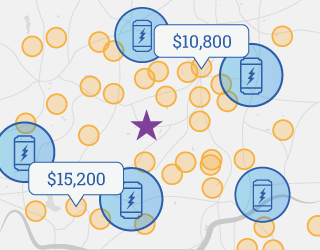Although utilities and the solar industry haven’t always had the most positive relationship across the country, there’s one distributed technology that utilities have been very quick to embrace: energy storage. When installed at a home or business, energy storage systems provide myriad benefits to both the owner of the system, as well as to the electricity grid as a whole. As a result, many utilities throughout the country are now actively encouraging the adoption of energy storage systems. Here are just a few of the reasons that utilities want you to have a battery.
But first – a quick refresher on how we pay for electricity
As explained in greater depth in our Electricity 101 section, there are a few key things that contribute to how much we pay for electricity: how much electricity we use, the maximum amount of electricity we use at any given time, and any upgrades to the transmission & distribution system. Energy storage can help reduce costs across all three categories: it can reduce how much electricity needs to be generated to meet home and business owner needs, it can reduce peak demand, and it can help defer or avoid the need for spending on transmission upgrades.
Reduce peak demand
The primary reason that utilities want you to have a battery is to reduce the “peak demand” of the electricity system. Peak demand is the maximum power draw on the electricity grid at any given time over the course of a day, month or year. In many parts of the country, peak demand occurs on the hottest days of the summer, at a time when everyone has their air conditioning units running at full blast.
Meeting peak demand is expensive to pay for: the types of power plants that are turned on when demand is at its highest will often only be turned on for 40 to 100 hours in total each year (out of the nearly 9,000 hours in the year), making them costlier to call upon when they are needed. Ultimately, the cost of paying for these expensive, infrequently used resources gets passed on to you and me as electricity customers.
However, by installing energy storage, homes and businesses can reduce the amount of electricity that they pull from the grid at times when the grid is stressed, which helps to reduce how frequently utilities have to turn on their most expensive power plants, ultimately saving money for all utility customers.
Reduce the impact of distributed solar on the grid
Utilities and grid operators have been worried about the impact that substantial volumes of solar could have on the way they operate the electricity grid. In short, the concern is that if solar generation gets high enough, it can actually change when the most electricity is needed for the grid, by requiring the most amount later in the day once the sun has set. To adjust for when electricity is most needed on the grid, many utilities are moving toward time of use rates, which make electricity more expensive between the hours of 4 to 8 pm or 5 to 9 pm.
However, if you pair your solar with an energy storage system, then, you can draw power from your battery instead of the grid during these more expensive hours. As a result, adding energy storage to solar panel systems can help to reduce the impact that additional distributed solar has on the grid.
Improve resilience for everyone
From a homeowner’s perspective, the most important thing that energy storage can provide is resilience. Specifically, energy storage can provide backup power to parts (or all) of your home in the event of an outage. In areas where electricity outages are frequent, due to major storm events, wildfires, ice storms, or an overstressed grid, encouraging home and business owners to install solar plus storage is a great way for a utility to ensure that their customers still have power even if the grid goes down.
This has co-benefits for all other utility customers. For instance, if a utility knows that some of their customers have solar plus storage and will still have power in their homes, the utility can focus on restoring power first to parts of the grid that may not have as wide of an adoption of solar plus storage, also reducing the number of customers whose electricity was ultimately out. Additionally, if enough storage is on the grid, certain neighborhoods may even be able to turn into microgrids, where they continue to operate as a miniature version of the electrical grid in the event of an outage.
Utility battery programs
As further proof that utilities want you to have a battery, many utilities now offer special rebates and incentives to their customers to install energy storage systems. From the ConnectedSolutions program in Massachusetts and Rhode Island, to Green Mountain Power’s innovative bring-your-own-device and Tesla rental programs, utilities are coming up with unique ways to encourage the adoption of energy storage systems.
Take advantage of utility battery programs with EnergySage
If your utility has a battery incentive, you can take advantage of these rebates and incentives by exploring your energy storage options on EnergySage. When you register for a free account on EnergySage, you can indicate your preference for receiving energy storage quotes, as well as tell potential installers why you’re interested in storage to help them quote the right solution for your needs. Get started comparing solar plus storage quotes through EnergySage today!






